Introduction
Cash flow modeling is a powerful tool for CFOs, offering a panoramic view of a company's financial health and guiding strategic decision-making. By integrating income statements, cash flows, and balance sheets, CFOs gain a comprehensive understanding of their company's financial operations. This article explores the basics of cash flow modeling, including building cash flow projections, estimating future cash flows, determining key inputs, calculating net cash flow, and integrating cash flow with financial statements.
It also delves into the importance of conducting sensitivity analysis and what-if scenarios, analyzing and interpreting cash flow projections, and common mistakes to avoid. Additionally, it highlights the tools and software available for cash flow forecasting and presents a case study to demonstrate the practical application of cash flow projection principles. With a confident and action-oriented tone, this article equips CFOs with practical advice and solutions to optimize their company's cash flow and drive financial success.
Understanding the Basics of Cash Flow Modeling
Cash flow modeling stands at the heart of sound financial management, serving as a dynamic tool that evolves with your business. It's not merely about tracking the money that enters and exits your company; it's a strategic apparatus for forecasting future financial scenarios and optimizing your company's cash position. The essence of cash flow modeling lies in its flexibility—permitting CFOs to adjust inputs as market conditions shift, thereby providing a panoramic view of the business's fiscal health.
At the core of this financial toolset, the Three Statement Model integrates income statements, cash flows, and balance sheets, offering a comprehensive perspective on a company's financial operations. This model, along with the Discounted Cash Flow Model, constitutes the bedrock of financial modeling, equipping CFOs with the means to navigate the intricate dance of revenues and expenditures.
The art of modeling cash flow also involves preparing for the full spectrum of business scenarios. By simulating the best and worst financial outcomes, a company can brace itself for any economic weather, ensuring agility and resilience. After all, a business that fails to plan for its cash flow dynamics is often one paycheck away from peril.
In a rapidly evolving business landscape, where companies like Intuit Inc. are reshaping their workforce to harness the power of AI and analytics, the importance of cash flow modeling becomes even more pronounced. A robust model empowers decision-makers to channel investments wisely, fueling growth and innovation. Moreover, understanding the nuances of cash flow versus profit is vital, as the former is the pulse that keeps a business robust, enabling it to meet obligations and seize opportunities as they arise.
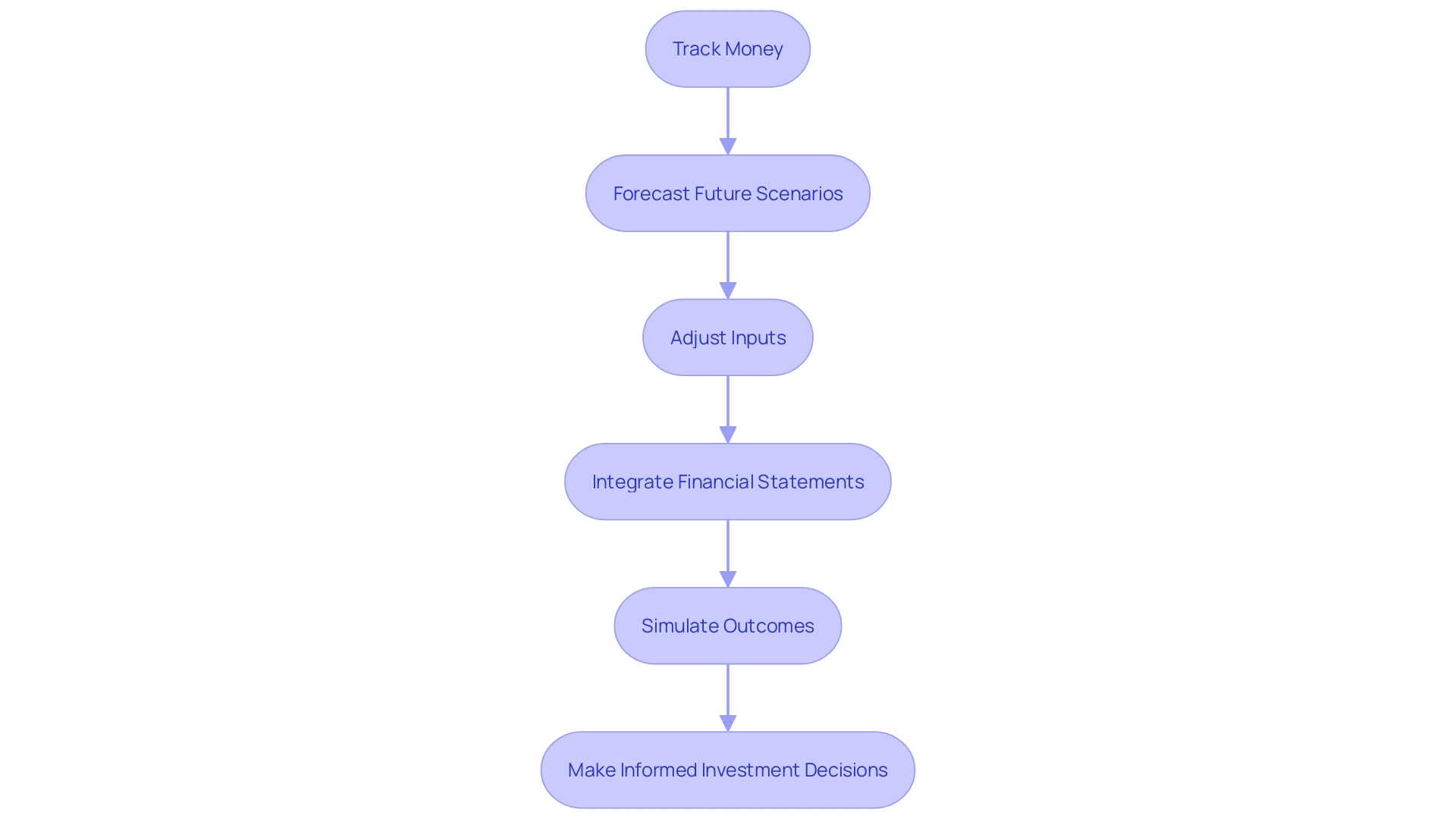
Step 1: Building a Cash Flow Projection
Crafting an accurate cash flow projection is pivotal for steering your business towards financial sustainability. The process begins with collecting relevant financial records, including past cash flow statements and projections for sales and expenses. From these, a meticulous analysis of historical data is conducted, considering factors such as revenue, operating costs, profit margins, and liabilities.
This historical review, ideally encompassing a minimum of three years, reveals patterns and growth trajectories critical to informed forecasting.
The next phase involves applying this data to forecast the financial future. Two distinct yet interlinked financial exercises play a role here: budgeting and forecasting. While budgeting defines financial goals for a set period, typically a fiscal year, forecasting uses historical and current performance to predict short or long-term business outcomes.
These predictions are then used to both establish and adjust the budget, ensuring financial targets remain aligned with operational reality.
Diving deeper, the Rule of X offers a strategic perspective, encouraging a growth mindset while balancing the cost implications. This rule underlines the importance of making forward-looking financial decisions that maximize the value potential of a business. For example, choosing to invest a dollar now with the expectation of a perennial return over an immediate dollar showcases the long-term thinking required for robust financial planning.
Investors, on their part, rely heavily on cash flow statements to assess a company's ability to generate future net cash flows, honor obligations, and return cash to stakeholders. A high-quality, audited statement of cash flows, free from restatements and material weaknesses in internal controls, is therefore essential. It not only reflects a company's operational efficiency but also its strategic financial management prowess.
Ultimately, the art of cash flow management is in recognizing the ebb and flow of business finances. By understanding these dynamics and proactively developing strategies to maintain a healthy balance, businesses can avoid the pitfalls of cash shortages. Remember, cash is not just the lifeline for day-to-day operations but also the key to seizing growth opportunities and achieving long-term success.
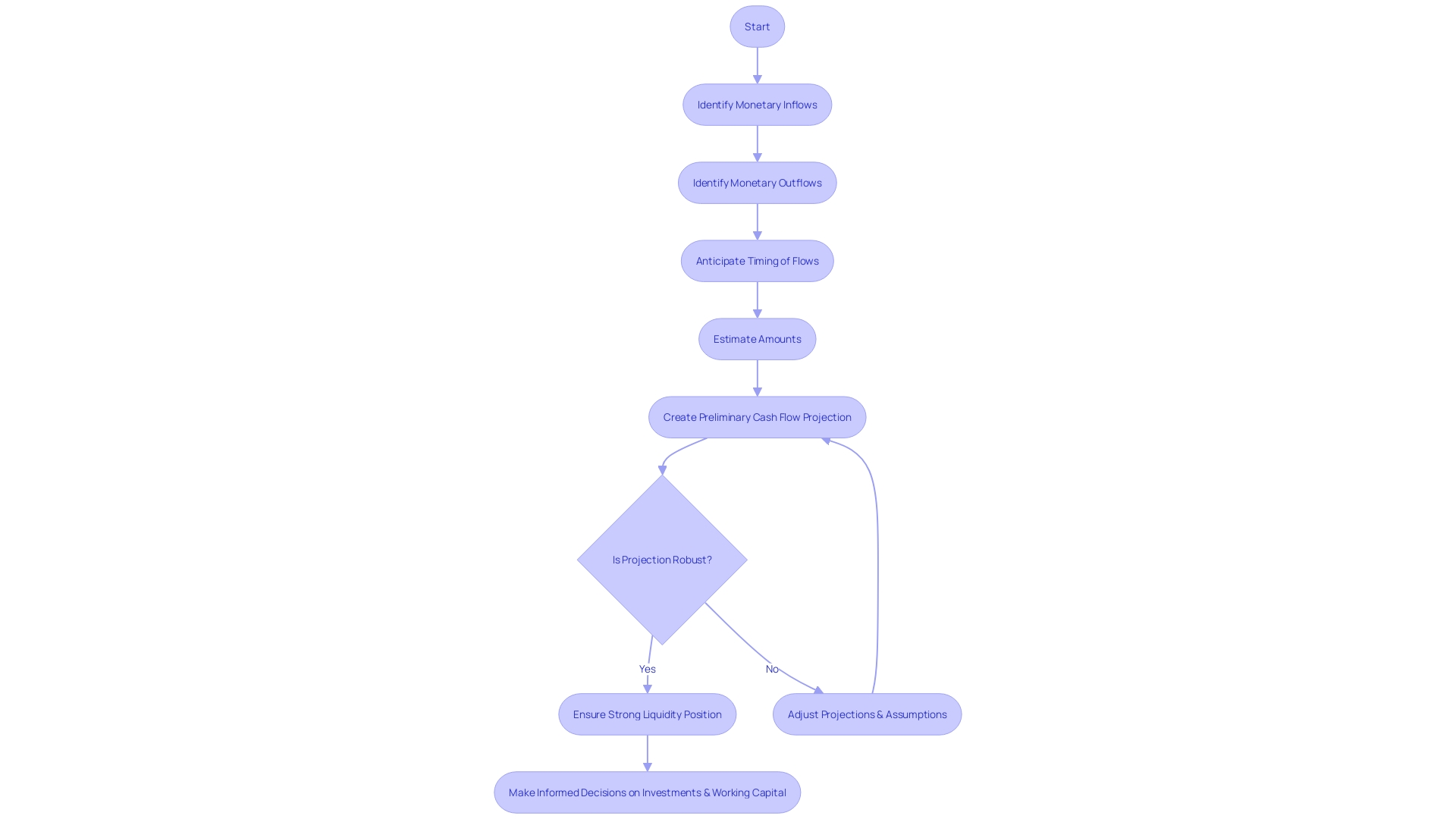
Step 2: Estimating Future Cash Flows
Forecasting future cash flows is a linchpin activity for CFOs who strive to steer their organizations towards financial success. By meticulously projecting both cash inflows and outflows, CFOs can effectively chart a course for the company's financial journey. To hone the accuracy of these forecasts, it's imperative to delve into historical financial data, keeping a keen eye on the company's past performance; this retrospection provides a foundation upon which reasonable future projections can be built.
Moreover, tapping into the insights provided by market trends and industry benchmarks can illuminate the path ahead, offering a broader perspective on potential financial outcomes. A notable approach involves evaluating the correlation between a company's investment levels—such as the expansion of retail space—and its revenue growth, acknowledging the direct impact that reinvestment has on sales figures.
A sophisticated technique that resonates with financial experts is Discounted Cash Flow (DCF) analysis. This method values the future cash flows by assessing their present value, which inherently acknowledges the time value of money. The DCF analysis starts with an estimation of expected cash flows over a period, considering variables such as net income, capital expenditures, and changes in working capital.
By doing so, it provides a nuanced view of an investment's worth, especially under fluctuating future conditions with alternating growth phases.
When forecasting revenue, which invariably affects cash flow projections, it's essential to recognize the complexity of accurately predicting future earnings. Investment in the business often serves as a significant driver, suggesting that understanding the company's strategic investments can serve as a strong indicator of future revenue streams.
As financial landscapes evolve, regulatory bodies such as the International Accounting Standards Board (IASB) continue to offer guidance on reporting financial uncertainties, including those related to climate change. Such resources support CFOs in their quest to maintain transparency and compliance in financial reporting, factors which directly influence cash flow modeling.
Ultimately, the successful management of cash flow hinges on a comprehensive understanding of all cash movements within the company. It's a delicate balance that requires vigilance to prevent cash shortages, which can be detrimental even to seemingly prosperous businesses. By employing advanced forecasting techniques, leveraging industry insights, and adhering to best practices in financial analysis, CFOs can ensure their companies remain on a trajectory of financial stability and growth.
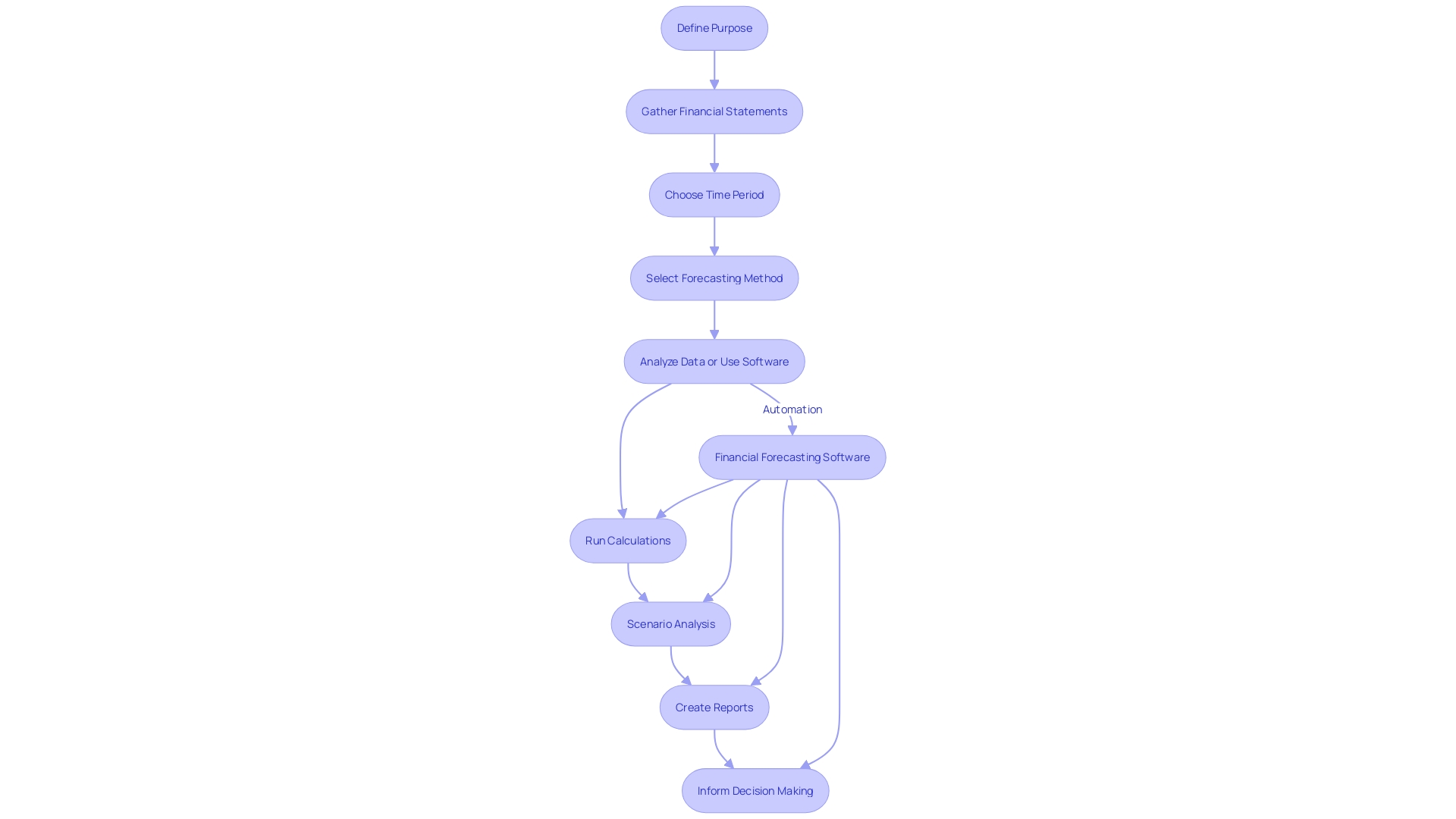
Step 3: Determining Key Inputs for Cash Flow Projections
Crafting an effective cash flow model requires meticulous attention to the primary elements that influence an organization's cash movements. For a CFO, discerning the pivotal inputs for cash flow forecasts is a foundational step towards establishing models that are not only precise but also dependable. Sales revenue, operating expenses, capital expenditures, and investment activities are among the critical drivers that shape the cash inflow and outflow patterns.
When structuring a cash flow projection, it's crucial to incorporate a growth model which translates the business operations into quantifiable analytics. This model serves as a strategic tool to discern how a business functions and where to channel resources to bolster growth. Despite the intricate work involved in creating these models, it's imperative to ensure their practical application within the company's financial strategies.
Recent consumer payment trends, as revealed by 2022 data, underscore the sustained preference for credit card usage and online payments, a pivot from traditional cash transactions. This shift has implications for revenue forecasting and necessitates a closer examination of payment methods' impact on cash flow. It's essential to consider these evolving behaviors in the financial ecosystem while modeling cash flow projections to ensure accuracy and relevance.
To encapsulate, a CFO must not only pinpoint and scrutinize the key inputs affecting cash flow but also stay abreast of market trends and consumer behaviors that could alter financial forecasts. By doing so, financial leaders can steer their organizations towards more informed and strategic financial decisions.
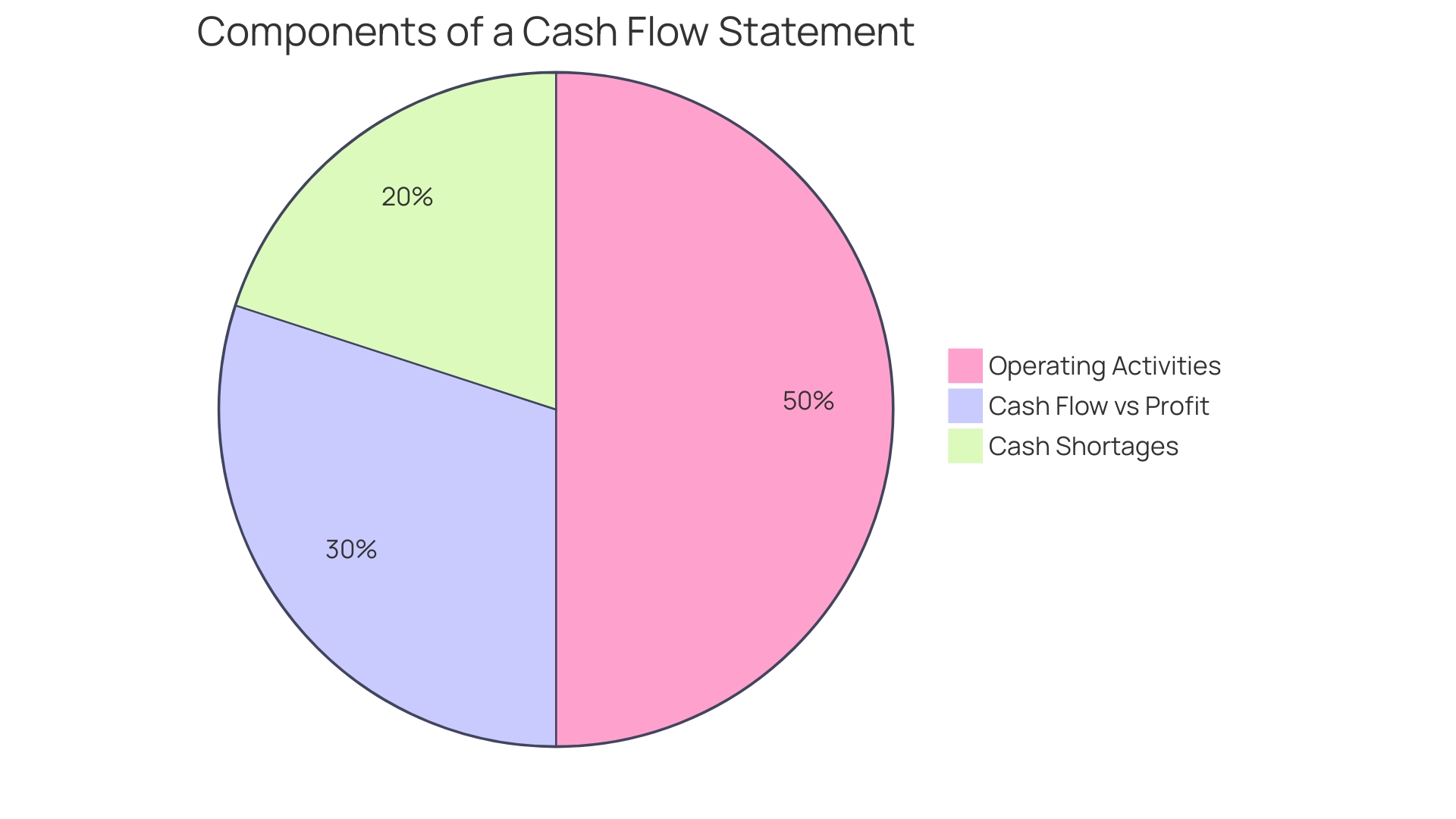
Step 4: Calculating Net Cash Flow
Understanding and calculating net cash flow is pivotal for maintaining a healthy financial position within a company. Net cash flow reveals the total amount of money being transferred into and out of a business over a specific timeframe, offering a clear view of the organization's profitability after all operational costs are covered. To determine net cash flow, one must accurately assess the Operating Cash Flow, which represents the revenue from normal business activities, and then subtract Capital Expenditures (CAPEX), the funds used for acquiring, upgrading, or maintaining physical assets.
For example, if a company's Operating Cash Flow is robust, this indicates efficient management of income from its core business operations. Then, understanding the CAPEX provides insight into the company's investments in long-term assets that will support future growth. When you subtract CAPEX from Operating Cash Flow, you derive the Free Cash Flow, a critical indicator of financial health.
A growing Free Cash Flow is indicative of an organization's ability to expand, return value to shareholders, and sustain operations. A recent highlight in the financial news showcased IBM's adept management of free cash flow, with the company exceeding Wall Street's expectations and consequently raising its full-year forecast, emphasizing the importance of free cash flow in creating shareholder value.
The net cash flow figure can be positive or negative. A positive net cash flow indicates that a company has more money coming in than going out, which is a sign of financial strength. Conversely, a negative cash flow suggests that a company’s outflows exceed its inflows, which could signal potential financial distress if not managed carefully.
By mastering these calculations and interpretations, CFOs can better strategize for financial growth, investment opportunities, and shareholder relations, ensuring the company navigates toward a prosperous future.
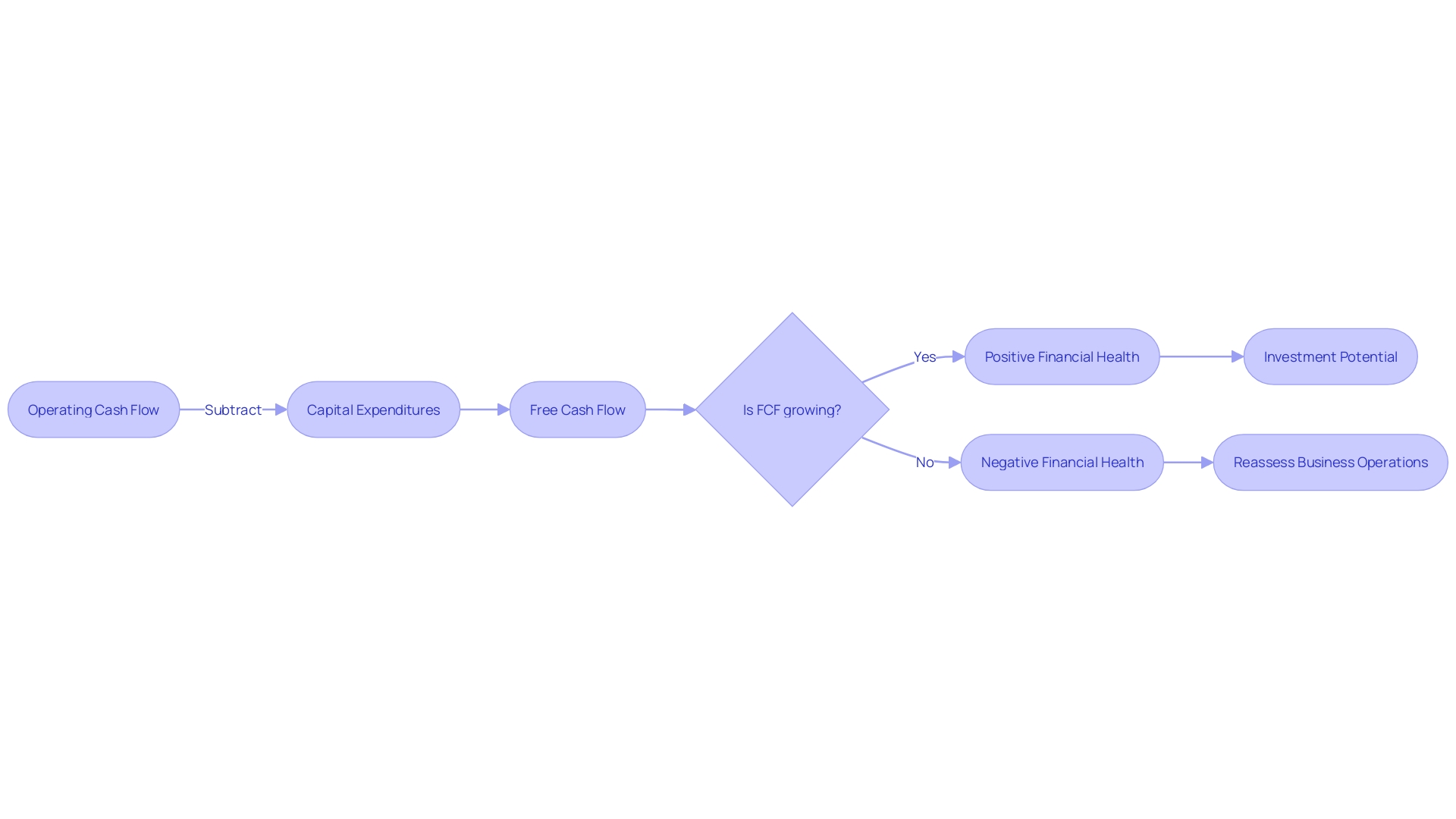
Step 5: Integrating Cash Flow with Financial Statements
A clear grasp of a company's cash flow in relation to its financial statements is a cornerstone for CFOs to accurately assess financial performance. Notably, the interplay between cash flow statements, income statements, and balance sheets can uncover discrepancies and secure financial precision. To achieve this, CFOs can learn from companies like Monday.com, which effectively managed cash flow to become free cash flow positive when growth decelerated.
This demonstrates the significance of efficiency in growth and the careful management of gross margins and free cash flow, ultimately enhancing shareholder value.
Moreover, companies that operate profitably without continuous venture capital, like those rare 'unicorns' found in Bain research, highlight the importance of operational cash flow at scale. L'Oréal's approach, as described in their 2022 Annual Report, exemplifies a business model that successfully balances beauty and fiscal prowess through diligent financial reporting, including cash flow statements.
Recent discussions, like the importance of cash flow reporting for investors highlighted on December 4, 2023, emphasize the need for the same meticulousness in cash flow statements as in other financial documentation. This precision assists investors in evaluating a company's ability to generate future net cash flows, meet obligations, and return cash to shareholders.
To further dissect a cash flow statement, the primary components include operating activities which reflect cash from core business operations, cash flow from investing and financing activities, and adjustments for non-cash transactions. This comprehensive view aids in discerning whether a company is sufficiently cash-generative through its operations or dependent on external financing, thereby providing insights into financial health and operational efficacy.
Understanding the connection between profit and cash flow is also essential. Whereas profit relates to the net earnings after expenses, cash flow is the net amount of cash and cash-equivalents moving in and out of a business. A healthy cash flow is critical to prevent shortages that could be fatal for a business, regardless of apparent success.
In conclusion, integrating cash flow analysis into financial statement review is more than a procedural task; it's a strategic imperative that informs investment decisions, financing strategies, and shareholder returns, as illustrated by successful companies like Monday.com and L'Oréal, and as underscored by investor-focused reporting standards.
Step 6: Conducting Sensitivity Analysis and What-If Scenarios
Sensitivity analysis and the creation of what-if scenarios are indispensable tools in the CFO's arsenal, providing a deeper understanding of potential financial outcomes in response to varying market conditions and internal business factors. These techniques allow for the examination of how changes in key variables such as pricing, cost structures, and market dynamics might affect cash flow projections. By engaging in this analysis, one can gauge the company's ability to withstand or capitalize on fluctuations in the economic landscape.
For instance, consider a company contemplating different growth paths. One such path might be optimizing sales processes before deepening the penetration of its existing customer base. Through sensitivity analysis, it becomes possible to predict how such strategic sequences might impact cash flow.
The insights gained are crucial for making informed decisions that align with the firm's financial stability and expansion objectives.
Moreover, recent discussions emphasize the importance of not hastily resorting to cost-cutting measures but rather reevaluating all expenditures in light of the company's long-term goals. This strategic approach involves a comprehensive review of the budget, prioritizing spending that supports core business objectives while identifying and potentially deferring or eliminating non-essential expenses.
The methodical nature of sensitivity analysis is further underscored by insights from discounted cash flow (DCF) valuation. DCF, a fundamental financial concept, entails estimating the present value of expected cash flows based on the principle that a dollar today is worth more than a dollar tomorrow. By applying this methodology, CFOs can discern the impact of various scenarios on the company's valuation, thereby mapping out the most financially advantageous strategic course.
Implementing these analyses often requires a meticulous understanding of the company's operational cash flow and capital expenditures (CAPEX), as these are critical components of free cash flow—the cash available after accounting for all expenses. To illustrate, if a company's operating cash flow is robust, and CAPEX is managed efficiently, the resulting free cash flow can signal healthy growth potential.
In conclusion, the dynamic nature of today's business environment demands that CFOs employ sensitivity analysis and what-if scenarios to maintain a proactive stance. These practices, supported by DCF principles and a judicious approach to financial management, are fundamental to optimizing cash flow and ensuring the organization's resilience and competitive edge.
Step 7: Analyzing and Interpreting Cash Flow Projections
Understanding and leveraging cash flow projections is a pivotal aspect of a CFO's role in steering a company towards financial success. To adeptly navigate this terrain, CFOs must become proficient in analyzing key metrics, recognizing trends, and applying industry benchmarks to their cash flow projections.
One fundamental aspect of this analysis is appreciating the importance of gross margins and their impact on free cash flow. As seen with companies like Monday.com, a thorough understanding of gross margins has been instrumental in their rapid growth and attainment of a positive cash flow position. This underscores the value of not treating all revenue equally, but rather evaluating it in the context of the costs incurred to generate it.
Rigorous examination of the factors driving gross margins, operational expenses, capital expenditures, and changes in working capital are essential for forecasting free cash flow margins, which are crucial for valuation. This approach was highlighted in a breakdown by Meritech Software Pulse, offering insights into the public SaaS industry's financial health and how best-in-class companies are distinguished.
Moreover, the evolving market dynamics, including socio-cultural, economic, and technological shifts, necessitate that companies adopt strategic growth paths. For instance, by prioritizing customer experience, businesses can enhance their product and service offerings, leading to improved customer engagement and, consequently, better financial outcomes.
The ability to ask incisive questions is a fundamental part of this financial scrutiny. Questions about the company's lifecycle, funding stage, and its annual performance relative to goals can inform necessary operational shifts. Similarly, understanding the unique financial landscape of 2024, with many startups adjusting to market changes, is critical for making informed decisions.
Finally, maintaining a clear distinction between cash flow and profit is vital for operational success. As stated in various industry insights, while profit is an essential indicator of financial health, cash flow is the lifeblood of a business. Preventing cash shortages is a non-negotiable aspect of managing a company, as cash flow issues can quickly escalate and lead to business failure.
By integrating these insights into their cash flow projections analysis, CFOs can ensure they are making informed decisions that will safeguard their company's financial stability and foster growth.
Common Mistakes to Avoid in Cash Flow Projections
To maintain the health and longevity of a business, it's crucial to have a robust understanding of both cash flow and profit. While profit represents the surplus after expenses are subtracted from revenue, cash flow is the actual movement of money into and out of the business, and it's vital for daily operations. A stable cash flow ensures that a business can meet its obligations, invest in growth opportunities, and avoid liquidity crises that could otherwise lead to financial distress.
CFOs often encounter pitfalls in cash flow projections that can jeopardize the accuracy and reliability of these forecasts. One of the most prevalent errors is neglecting a comprehensive review of all financial statements, including the cash flow statement, income statement, and balance sheet. These documents collectively offer a snapshot of the company's financial health, encompassing revenue, expenses, profitability, and debt.
Dr. Sharon H. Porter emphasizes the importance of being intimately familiar with these figures, asserting that 'knowing your numbers' is crucial for sustained success.
Another pitfall is the absence of a strategic plan for fund allocation. Investments should be scrutinized not only for their immediate costs but also for their potential return on investment. This foresight is essential for sustainable cash flow management.
In practice, a common challenge for businesses is translating financial insights into actionable strategies. Growth models, often represented in spreadsheets, are designed to guide resource allocation and stimulate growth. Despite their potential, these models are frequently underutilized, which can impede a company's progress.
Recent reports highlight the gravity of cash flow challenges faced by businesses, with 40% of surveyed small businesses grappling with inconsistent cash flow and nearly 30% lacking reserves for unexpected setbacks. These financial hurdles often force business owners to make sacrifices, such as forgoing their own salaries or missing out on business opportunities.
To mitigate these issues, a proactive approach is required. Begin by reassessing all expenditures with your long-term objectives in mind. This involves a thorough examination of the budget, prioritizing expenses and income streams without resorting to indiscriminate cost-cutting.
Careful financial planning and management can ensure the vitality of your business, enabling it to thrive in any economic climate.
Tools and Software for Cash Flow Forecasting
Harnessing the power of advanced tools and software is essential for CFOs aiming to enhance the precision and efficiency of cash flow forecasting. By automating the data collection process, executing intricate calculations, and producing insightful reports, technology serves as a formidable ally in finance management. A standout among these tools is the Long Term Growth Model (LTGM), an Excel-based application that extends the classic Solow-Swan Growth Model to explore long-term growth scenarios.
Its design prioritizes simplicity and ease of use, requiring minimal data and avoiding macros, which makes it a suitable option for creating country reports and planning documents. However, it's important to note that LTGM is intended for long-range planning rather than short-term predictions.
Another innovative approach is the Lean Canvas methodology, crafted by Ash Maurya. This one-page business plan template distills an idea into twelve fundamental components, providing a clear and concise outline of a business model, product launch, or feature. Its simplicity and speed make it an admirable tool for expressing ideas to stakeholders and can often replace the extensive process of drafting a traditional business plan.
In light of the difference between budgeting and forecasting—where budgeting sets financial targets for a fiscal year while forecasting predicts future performance—selecting the right forecasting tool is critical. These chosen tools not only aid in setting the initial budget but also in tracking progress. Understanding the movement of cash in and out of the business is crucial, as emphasized by the adage 'Cash is queen.'
A robust cash flow management strategy is pivotal to avoid the dire consequences of cash shortages, which can swiftly lead to a business's downfall.
To implement effective cash flow management, it's imperative to first establish the goal of the financial forecast, amass all necessary financial data, and choose an appropriate forecasting method and timeline. Whether performing the calculations manually or utilizing financial forecasting software, the ultimate objective is to maintain a healthy financial balance, enabling strategic investments and business growth. In this context, the appropriate forecasting tools can be a game-changer for CFOs, providing them with the clarity and control needed to steer their organizations towards financial stability and success.
Case Study: Example of a Cash Flow Projection
Delving into a case study sheds light on the intricacies of cash flow projection, offering CFOs actionable insights tailored to their strategic financial needs. By walking through an illustration, we unravel the methodology and link it to a customizable Google sheet, enhancing the practicality of the tools provided. Although the numbers are fictional, the principles are widely applicable.
For example, understanding that website search traffic results from individual URL performances, each contributing to the total, is analogous to how a cash flow projection is built from various revenue streams and cost centers.
The term 'unicorn' serves as a metaphor for businesses that reach a $1 billion valuation and operate profitably without constant capital injections—akin to the rare entities that master cash flow to fuel sustainable growth. This is exemplified in our case study, which highlights the essential steps for creating robust cash flow models. These steps are crucial for CFOs to replicate and apply in their organizations, transforming their financial forecasting into a strategic asset.
The case study also touches on the difference between budgeting and forecasting. The former sets financial targets for a fiscal year, while the latter uses predictions based on past and current performance to inform those targets. This distinction is key in optimizing cash flow management.
The narrative is supported by the experience of a hotel that leveraged its prime location to increase sales significantly. This example emphasizes the importance of strategic planning and knowing your market to maximize cash flow.
In the voice of industry experts, we explore the challenges and preferred methods for forecasting revenue. The consensus is that investment in the business, whether through capital expansion or reinvestment of earnings, is a major driver of future sales. This principle is incorporated into the case study, providing CFOs with a pragmatic approach to predict and manage revenue streams.
To underscore the impact of financial forecasting on cash flow, statistics reveal that a business with $5 million in revenue and a $500k EBIT can transact $190k in cash weekly to generate $10k in profit. This 19:1 ratio between cash transactions and profit emphasizes the amplifying effect that even small changes in business economics can have on cash flow, a critical insight for financial leaders.

Conclusion
Cash flow modeling is a powerful tool for CFOs, providing a comprehensive view of a company's financial health and guiding strategic decision-making. By integrating income statements, cash flows, and balance sheets, CFOs gain a deep understanding of their company's financial operations.
Building a cash flow projection is crucial for financial sustainability. It involves analyzing historical data and forecasting future financial scenarios. By simulating different scenarios and conducting sensitivity analysis, CFOs can prepare their company for any economic weather.
Estimating future cash flows accurately is essential for steering organizations towards financial success. Techniques like Discounted Cash Flow (DCF) analysis provide a nuanced view of an investment's worth, especially under fluctuating future conditions.
Determining key inputs for cash flow projections is foundational in creating an effective cash flow model. CFOs must consider sales revenue, operating expenses, capital expenditures, and investment activities. Staying updated on market trends and consumer behaviors is crucial for accurate financial forecasts.
Calculating net cash flow is pivotal for maintaining a healthy financial position. CFOs must assess operating cash flow and subtract capital expenditures to determine net cash flow.
Integrating cash flow analysis with financial statements is essential for assessing financial performance accurately. Understanding the connection between profit and cash flow is vital, as cash flow is the lifeblood of a business.
Sensitivity analysis and what-if scenarios provide a deeper understanding of potential financial outcomes. CFOs can gauge their company's ability to withstand or capitalize on fluctuations in the economic landscape.
Analyzing and interpreting cash flow projections is crucial for financial success. CFOs must understand key metrics, recognize trends, and apply industry benchmarks.
Avoiding common mistakes in cash flow projections is crucial. CFOs must conduct a comprehensive review of financial statements, have a strategic plan for fund allocation, and translate financial insights into actionable strategies.
Advanced tools and software enhance the precision and efficiency of cash flow forecasting. Long Term Growth Model (LTGM) and Lean Canvas methodology are valuable tools for long-term planning and expressing ideas to stakeholders.
In conclusion, cash flow modeling empowers CFOs to optimize their company's cash flow and drive financial success. By following the steps outlined in this article, CFOs can gain a deep understanding of their company's financial health, make informed decisions, and ensure financial stability and growth.




